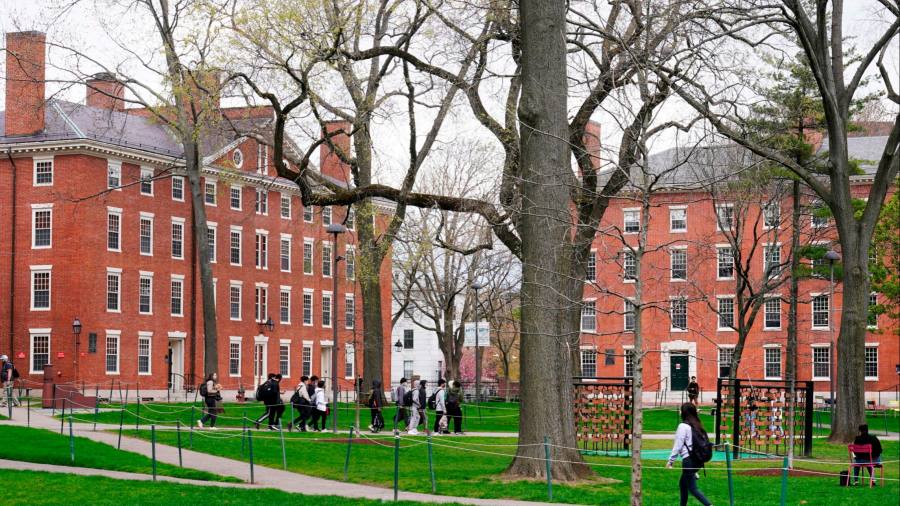Receive free Supreme Court US updates
We’ll send you a myFT Daily Digest email rounding up the latest Supreme Court US news every morning.
The US Supreme Court has curbed universities’ ability to consider race in admissions, a ruling that could have far-reaching consequences for diversity policies at employers across the country.
The decision on Thursday came in two of the most high-profile cases heard by the Supreme Court this term. The cases against the University of North Carolina, a public university, and Harvard University, the private Ivy League institution, were brought by Students for Fair Admissions, a non-profit seeking to abolish racial considerations in admissions.
Students for Fair Admissions had argued the practice benefited black and Hispanic students to the detriment of Asian Americans and others. It asked the court to over-rule Grutter vs Bollinger, a landmark 2003 Supreme Court decision that allowed universities to consider race in admissions by reaffirming that diversity is in the government’s interest.
In the majority decision, the court’s six conservative justices held that affirmative action in the schools’ admissions programmes violated the US Constitution’s equal protection clause. The three liberal justices dissented in the University of North Carolina case, although Ketanji Brown Jackson had recused herself from the Harvard case.
Students “must be treated based on his or her experiences as an individual — not on the basis of race”, Chief Justice John Roberts wrote in the majority ruling. “Many universities have for too long done just the opposite. And in doing so, they have concluded, wrongly, that the touchstone of an individual’s identity is not challenges bested, skills built, or lessons learned but the colour of their skin. Our constitutional history does not tolerate that choice.”
Nevertheless, “nothing in this opinion should be construed as prohibiting universities from considering an applicant’s discussion of how race affected his or her life, be it through discrimination, inspiration or otherwise”, Roberts wrote.
Liberal Justice Sonia Sotomayor wrote in dissent that the court’s decision “stands in the way and rolls back decades of precedent and momentous progress”, and “cements a superficial rule of colourblindness as a constitutional principle in an endemically segregated society where race has always mattered and continues to matter”.
She added that the court “subverts the constitutional guarantee of equal protection by further entrenching racial inequality in education, the very foundation of our democratic government and pluralistic society”.
The universities had warned that barring colleges from considering race in their admission process would jeopardise the ability to build a diverse student body and urged the court to consider its “educational benefits”.
In a brief filed in support of the schools, the Association of American Medical Colleges argued that “diversity in medical education and practice can help alleviate” health inequality damaging racial minorities in the US, with black and Hispanic medical school graduates likelier on average “to consider serving underserved communities”.
The court’s decision dealt a “setback to colleges’ diversity programmes”, said Sonja Starr, professor at the University of Chicago Law School.
“It’s really only the beginning of the legal battles that are to come,” she added. “What’s at stake is actually an issue that goes well beyond education, covering the future of colourblindness doctrine.”
The US business community also watched the cases closely. Dozens of large companies including American Airlines, General Electric, Meta, Google and Apple filed a brief in support of the colleges, arguing that “prohibiting universities nationwide from considering race among other factors in composing student bodies would undermine businesses’ efforts to build diverse workforces”.
Legal experts have warned that a loss for the universities might mean companies will be the next to face similar legal challenges over diversity practices.
Court watchers have highlighted how the bench, which is split 6-3 between conservative and liberal justices, has seemed more inclined to challenge longstanding legal precedents than some of its predecessors. Last year it overturned the landmark 1973 Roe vs Wade decision that had enshrined the constitutional right to abortion for nearly five decades.
The decision was immediately celebrated by Republican presidential candidates, including ex-president Donald Trump, former vice-president Mike Pence and former UN ambassador Nikki Haley.
Haley, who is Indian-American, issued a statement that said: “Picking winners and losers based on race is fundamentally wrong. This decision will help every student — no matter their background — have a better opportunity to achieve the American dream.”
Democrats decried the ruling. Chuck Schumer, the Senate’s top Democrat, said the justices had “put a giant roadblock in our country’s march towards racial justice”.
Read the full article here




